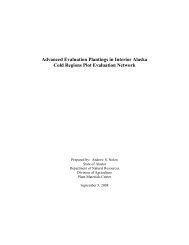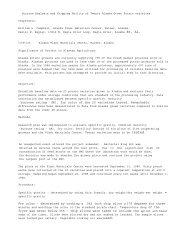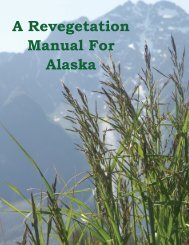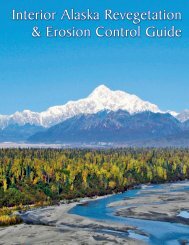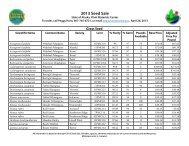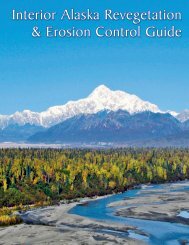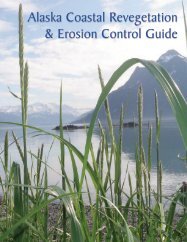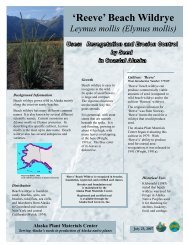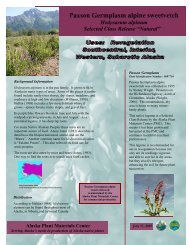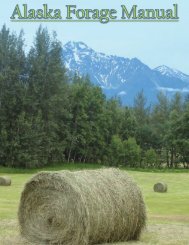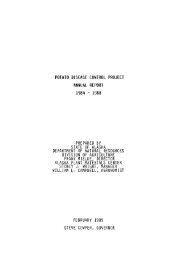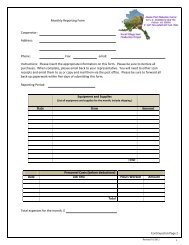Alaska Forage Manual - Alaska Plant Materials Center - State of ...
Alaska Forage Manual - Alaska Plant Materials Center - State of ...
Alaska Forage Manual - Alaska Plant Materials Center - State of ...
Create successful ePaper yourself
Turn your PDF publications into a flip-book with our unique Google optimized e-Paper software.
Endophytes<br />
Endophytes are organisms that live inside<br />
plants; they can be bacteria, fungi, or nematodes.<br />
Many survive only inside living plants and are transmitted<br />
from mother plant to seed. There are endophytic<br />
fungi that have mutualistic associations with<br />
their plant hosts (benefiting both organisms), however,<br />
some <strong>of</strong> these fungi produce toxins. The toxins<br />
produced can discourage feeding and can weaken<br />
or kill grazing animals. Not all members <strong>of</strong> an endophyte<br />
species produce toxins; growing conditions<br />
and time <strong>of</strong> year can also affect toxin loads. Generally,<br />
toxins are at their highest concentration in the<br />
crowns and seed heads. Many <strong>of</strong> the toxins can persist<br />
in stored hay for several years.<br />
Symptoms <strong>of</strong> Endophyte Poisoning In Animals<br />
Clinical symptoms are related to the type <strong>of</strong><br />
toxin present. The ergot alkaloids present in fescues<br />
cause constriction <strong>of</strong> blood vessels; symptoms include<br />
elevated body temperature (animals may stand<br />
in water), increased respiration, excessive salivation,<br />
restricted blood flow, “fescue foot” (dry gangrene in<br />
extremities) in cold weather, “fat necrosis”, nervousness,<br />
arched back, reduced weight gain, lowered<br />
reproduction, reduced milk production, and roughened<br />
hair coat. Ergot alkaloids can also be present<br />
in perennial ryegrass. The predominant toxin is typically<br />
lolitrem B, a tremorgen that causes tremors and<br />
muscle spasms. Lolitrems are the cause <strong>of</strong> “ryegrass<br />
staggers,” a condition in which the animal displays<br />
outstretched neck and limbs, tremors, stiff limbed<br />
gait, reluctance or inability to rise, disorientation,<br />
reduced weight gain and reduced prolactin levels.<br />
Tremors and disorientation are more pronounced<br />
when animals are excited.<br />
How to Identify Endophyte Infected Grass<br />
Endophyte infection does not generally cause<br />
outward symptoms in host plants, though they may<br />
appear more vigorous than neighboring plants,<br />
or may experience less grazing pressure. In cases<br />
<strong>of</strong> isolated toxin production in a pasture, the area<br />
may be fenced <strong>of</strong>f or livestock may feed on limited<br />
quantities <strong>of</strong> infected grass. Toxin production <strong>of</strong>ten<br />
increases with plant stress (heat, drought, overgrazing).<br />
Lush growth from excessive nitrogen fertilization<br />
should be avoided. Avoid feeding crown tissue<br />
at any time <strong>of</strong> the year. Mow or graze infected areas<br />
before seed heads develop, since they can contain<br />
the highest concentrations <strong>of</strong> toxins.<br />
Infected pastures should be avoided in the<br />
late summer or early fall when toxin levels are high.<br />
In more extreme cases <strong>of</strong> high toxin loads or widespread<br />
toxin production, pastures may need to be<br />
killed and replanted. Pastures should NOT be replanted<br />
with lawn mixes (endophytes can be desirable<br />
to protect lawns). Many pasture grasses are<br />
tested for fungal endophytes. “E +” or “E -” labels<br />
on seed mixes indicate the presence or absence <strong>of</strong><br />
endophytes; other labeling systems indicate the<br />
percent <strong>of</strong> infected seed. There are also varieties <strong>of</strong><br />
pasture grass containing endophyte strains that do<br />
not produce mammalian toxins, these provide nutritional<br />
and survival benefits to the plant without risk<br />
<strong>of</strong> livestock poisoning.<br />
Laboratory testing is available to confirm the<br />
presence <strong>of</strong> endophytes and their toxins. Please contact<br />
the <strong>Alaska</strong> <strong>Plant</strong> <strong>Materials</strong> <strong>Center</strong> at (907) 745-<br />
4469 if you suspect you may have endophyte problems<br />
in your pasture.<br />
14



